Live like a Maharajah or Maharani in one of these opulent palace hotels in India. You’ve got to do it at least once in your lifetime! Lavish silk drapes, chandeliers from Europe, plush Persian carpets and rooms filled with antiques. India’s palace hotels are a reminder of an extravagant era when Maharajah’s reigned supreme. While India is a vast and beautiful country with many stunning natural Indian landmarks, India’s palaces are a sight to behold.
Many were residences of India’s royal families while others were designed with a level of opulence that would please any royal visitor, with top-notch service, and a well-trained army of staff at one’s beck and call. Most palace hotels are in Rajasthan and the northern part of India but if you’re looking to travel around the south, you’ll also find places to visit in South India with equally impressive palace hotels. Escaping into a royal fantasy is something lovers of luxury escapes could easily slip into while travelling in India and a real treat. Here are 22 regal experiences.
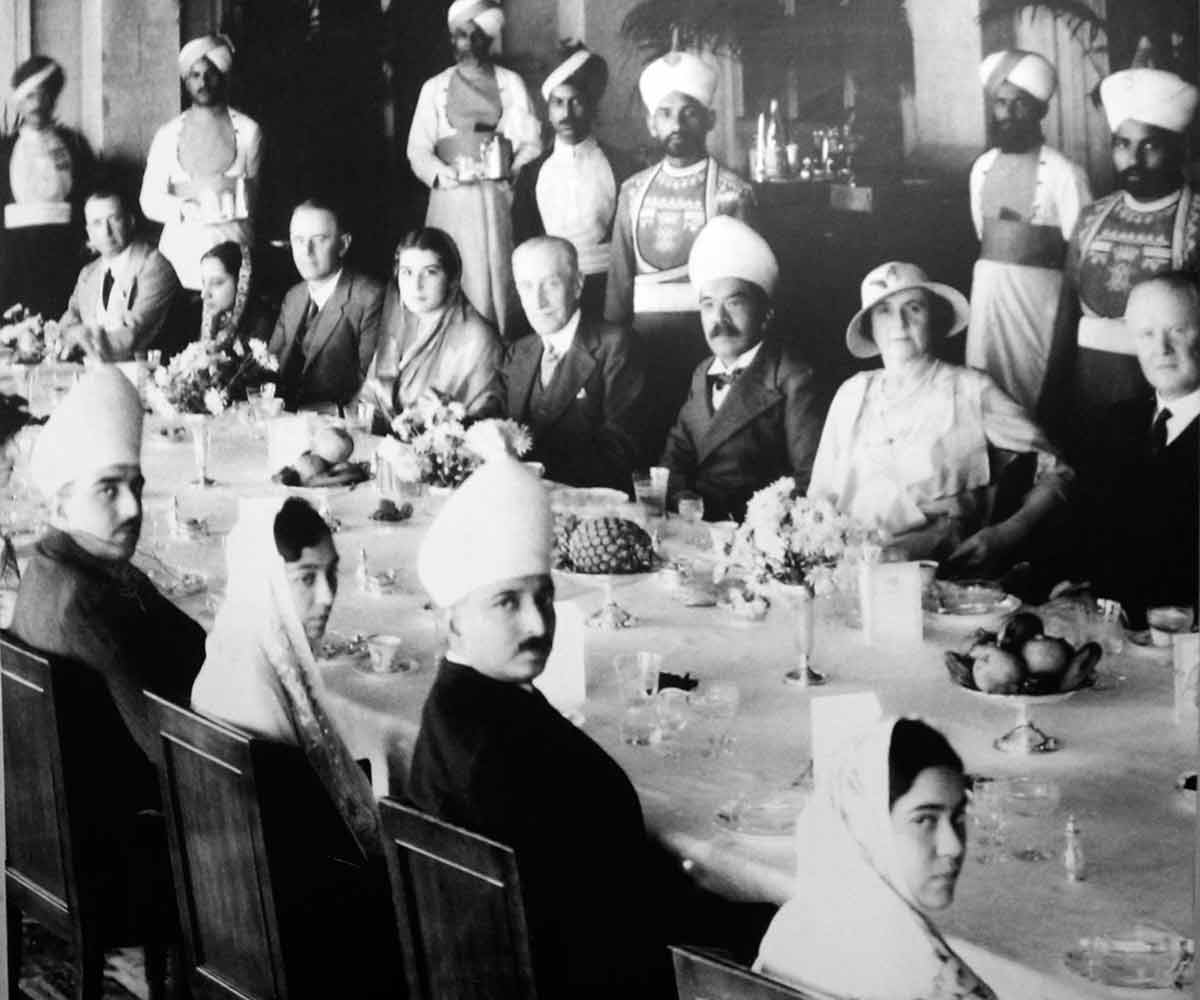
Contents
- Palaces In India
- Iconic Palaces In India
- Palace Hotels In India
- 7- Umaid Bhawan Palace, Jodhpur
- 8- Taj Lake Palace, Udaipur
- 9- Taj Fateh Prakash Palace, Udaipur
- 10- Neemrana Fort Palace
- 12- Falaknuma Palace, Hyderabad
- 13- Taj Mahal Palace, Mumbai
- 14- Devi Garh, Udaipur
- 15- The Leela Palace, Udaipur
- 16- The Imperial, New Delhi
- 17- Oberoi Grand Kolkata
- 18- Maison Perumal, Pondicherry
- 19- Taj Nadesar Palace, Varanasi
- 20- Ferrnhills Royale Palace, Ooty
- 21- Chapslee, Shimla
- 22- Ahilya Fort Hotel, Maheshwar
Palaces In India
Iconic Palaces In India
1- Udaipur City Palace, Rajasthan
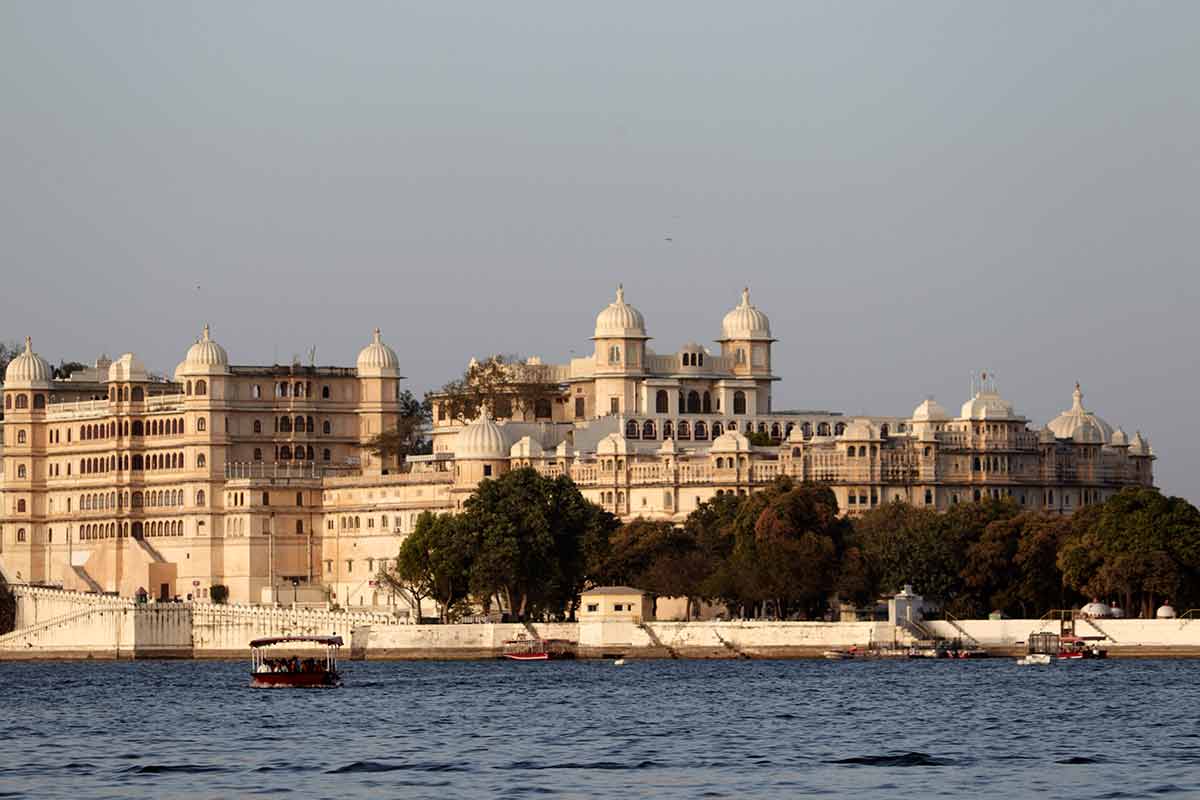
Tired of switching capitals to save the kingdom from the marauding Marathas and Mughals, the Mewar clan of Rajasthan finally chose to erect their capital in the natural sanctuary of the imposing Aravalli by the lakeshore of Pichola in Udaipur.
Udaipur City Palace was gradually built over 400 years of Mewar rule by a combined effort of 22 generations of Sisodia Rajputs.
This palace complex comprises 11 palaces, and the architectural style ranges from Medieval, European to Chinese. The palace construction began in 1559.
Although the surroundings offered them plenty of protection, that didn’t ease the Mewar’s minds.
They constructed the palace’s corridors in a zigzag way to confuse the enemy and evade a surprise attack for extra security.
The interior housed all their wealth and was decked out with spectacular intricate mirrors, marble, inlay works and a stained glass-covered balcony.
History hunters will find their fill in the grand gateways with marble arches, the beautiful hanging gardens of Amar Vilas, exhibits of miniature paintings in Badi Mahal and Bhim Vilas, Chinese and Dutch ornamental tiles in Chini Chitrashala, and the beautiful murals of Dilkhusha Mahal.
Don’t miss the mirror glass work of Manak Mahal, which is one of the most beautiful structures of City Palace.
Udaipur City Palace is in Old City, Udaipur, Rajasthan 313001.
2- Chowmahalla Palace, Hyderabad
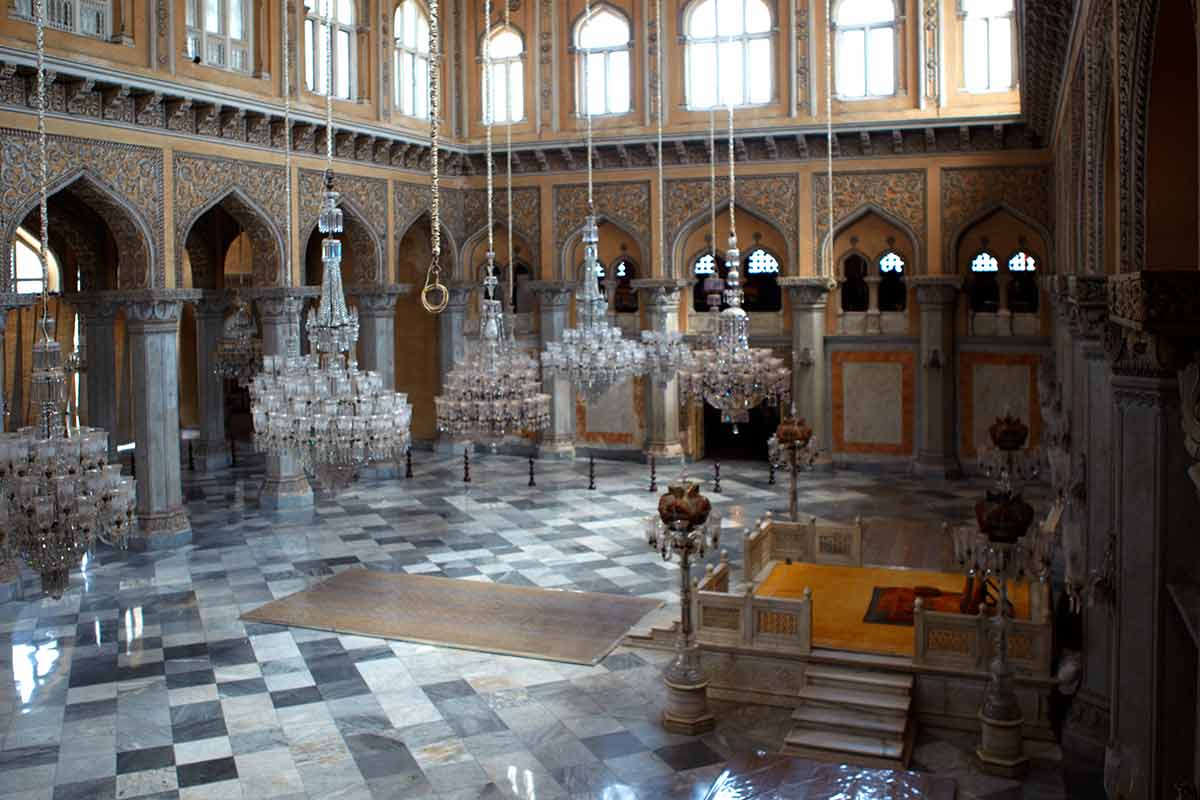
No Nizami trail of Hyderabad is complete without stepping a foot in the actual seat of power from where they flexed their strength and might.
Chowmahalla Palace, or ‘four palaces’, was inspired by the Shah of Iran’s Palace and took nearly a century to complete.
Initiated by Nizam Salabhat Jung in 1750, the majestic monument was completed in the 1880s during the fifth Nizam of Hyderabad, Afzal ad-Dawlah Asaf Jah V’s, rule.
As trends and tastes shifted through time, those trends are captured in the architectural influences seen in this palace complex.
Glimpses of Persian, Indo-Saracenic, European, and Rajasthani styles are evident in the palace facade.
The complex has many sections, including the northern and southern courtyards and an elaborately carved entrance fountain.
The old southern courtyard has four palaces – Afzal Mahal, Mahtab Mahal, Tahniyat Mahal, and Aftab Mahal. In contrast, the northern courtyard contains the Bara Imam or the administrative block and Shishe-Alat.
Apart from admiring the grandeur of yesteryear while exploring the exhibits of crockeries, costumes, coins, and armouries, the other stunning sights are the glamorous Durbar Hall with its picturesque pillars and nineteen spectacular Belgian chandeliers.
The Quran collection is phenomenal, so don’t miss the rare handwritten Quran on display and a Quran printed in metal and inscribed with gold.
The vintage car collection is complete with a Rolls Royce, and the Buggee display is also impressive.
Chowmahalla Palace is at 20-4-236, Motigalli, Khilwat, Hyderabad, Telangana.
3- Laxmi Vilas Palace, Gujarat
Dominating the landscape of Vadodara is Laxmi Vilas Palace, a mammoth 500-acre (202 ha) private residence of the Gaekwads.
It was built in the 1890s by Maharaja Sayajirao Gaekwad III and is a mishmash of Mughal, Rajput, Jain, Gujarati, and Venetian styles of architecture and interior design.
Laxmi Vilas Palace is four times larger than Buckingham Palace and has a golf course and a cricket ground within its compound.
Its sheer size forces visitors to access different buildings from different entrances. The expansive lawns have roaming peacocks making for a stately sight.
You can learn about the palace through a self-guided audio tour of the historic section of the property but not the residential area, as the royal family still lives in the palace, and their living quarters are off-limits.
- Highlights include:
- Sculptures created with meticulous detail.
- The arms gallery or Pratap Shastragaar.
- The 300 ft (91 m) clock tower.
- Paintings by Raja Ravi Verma in the Gaddi Hall and the coronation room.
The spectacular Durbar Hall is an engineering feat worth admiring that stands 95 feet (29 m) long with no pillar support.
Laxmi Vilas Palace is at J N Marg, Moti Baug, Vadodara, Gujarat.
4- Mysore Palace, Karnataka
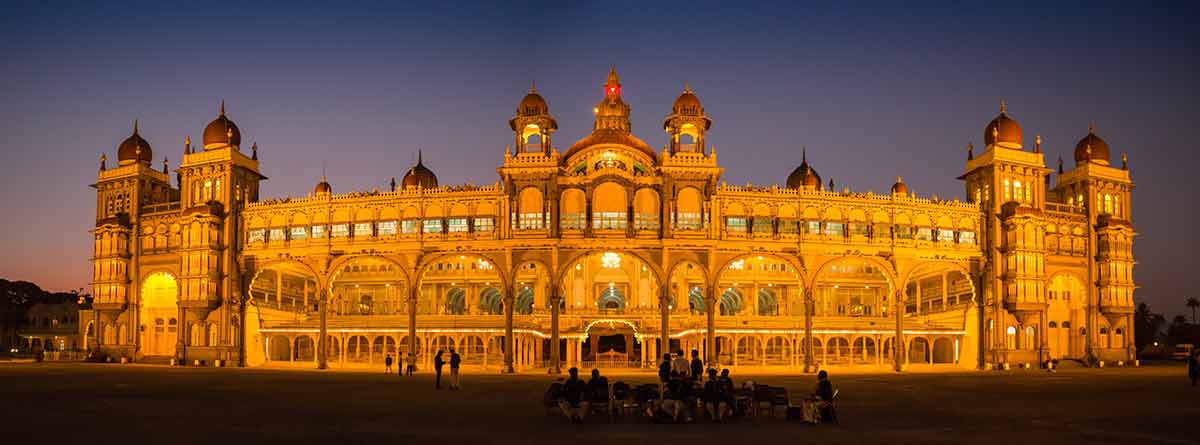
If the proverbial phoenix that rose from its ashes had a palace counterpart in India, Amba Vilas Palace (popularly known as Mysore Palace) is it.
Destroyed by lighting, grazed to the ground by a freak fire accident, palace ground decimated by Tipu Sultan during his rule, and a curse of impotency by a Queen couldn’t stop this palace from rising back up many times over.
Along with it, the longest-serving Mysuru rulers of the Wadiyar dynasty also flourished. Believe it or not, it still serves as the official residence of this noble family.
It took five centuries worth of tweaking to create its present facade after the initial fort-like structure was completed in 1574.
The new palace, which draws heavily from Buckingham Palace in its sheer size and expanse, was completed in 1912.
The final architectural style is a blend of Islamic, Gothic, and Rajput.
Displays of wealth and prosperity are evident throughout the palace’s interiors.
The ornate ceilings and sculpted pillars of Durbar Hall, the stained glass windows, and the floral mandalas of Kalyanamantapa are impressive sights.
Paintings of Raja Ravi Verma, doors made of solid silver, Tipu Sultan’s sword, a jewel-studded throne believed to have belonged to the Pandavas, a ‘haathi-howdah’ or elephant carriage made with 84 kgs of gold, canons, and Czechoslovakian chandeliers are some of the highlights of a palace visit.
The palace steals the show during the festive time of Dussehra when it’s decked out with twinkling lights, creating an awe-inspiring sweeping spectacle.
Mysore Palace is at Sayyaji Rao Rd, Agrahara, Chamrajpura, Mysuru, Karnataka.
5- Jaipur City Palace, Rajasthan
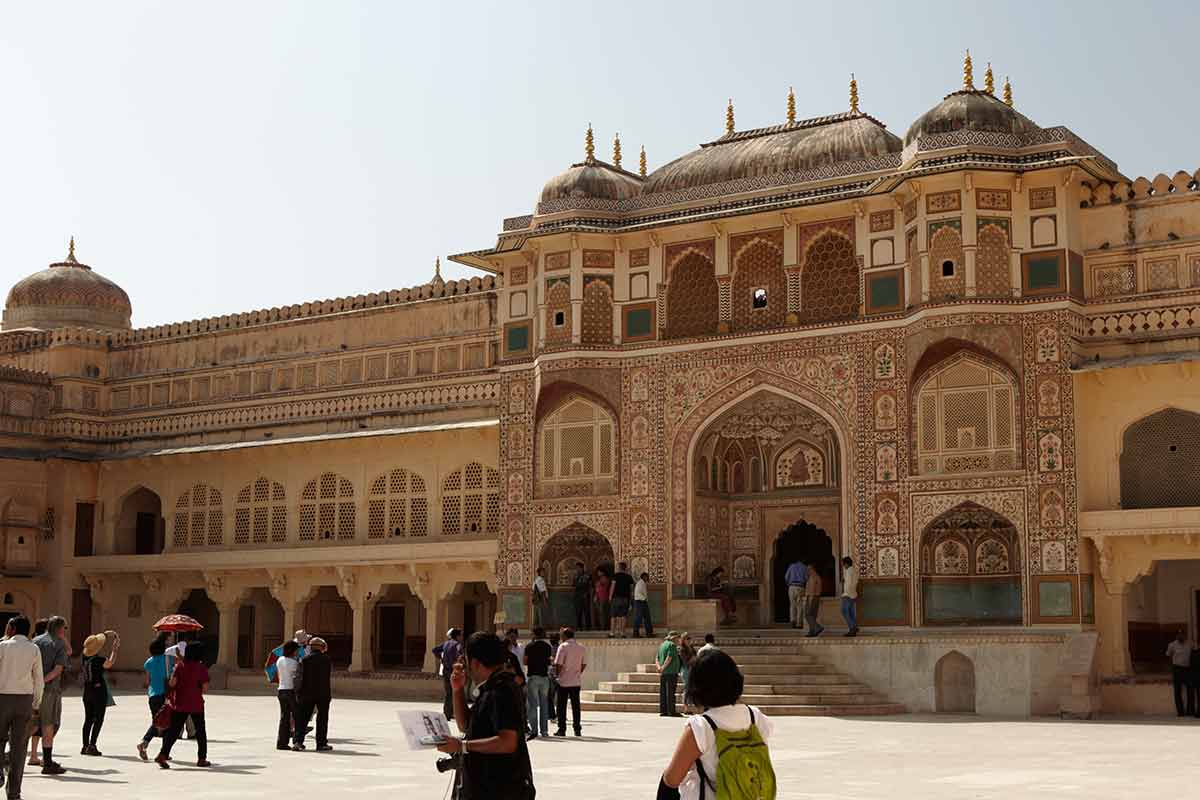
Completed in 1732, Jaipur City Palace is the cradle of the Pink City of Jaipur.
It had a humble beginning as a hunting lodge for the royal family that was converted to this palatial extravaganza when Maharaja Sawai Jai Singh II shifted his administrative capital from Amer to Jaipur to battle the drought in his kingdom.
The palace is a complex of courtyards, pavilions, buildings, temples, and gardens, each with its own wow factor.
The architecture is a fusion of Mughal, Rajput, and European styles.
Another unique feature is the architects employed the ancient Indian architectural science of vastushastra when designing the complex.
A precision of planning is evident in the complex’s grid-like layout, which is also reflected in the town planning of old Jaipur.
Its ornate exterior and eye-catching detail will captivate any visitor, starting at the richly decorated palace gates.
Marble pillars, painted plaster ceilings, jaali work on palace partitions, bejewelled thrones, intricate stone carving, murals, and chandeliers will captivate you for hours.
Chandra Mahal has been converted to a museum where you can catch a glimpse of the royal past.
The large pichhwai painting of Lord Krishna in Govind Ji’s temple is the epitome of regional folk art.
Don’t miss the two 5.2 ft (1.6 m) sterling silver vessels recorded in the Guinness Book of Records made from 14,000 melted silver coins without any soldering involved.
Jaipur City Palace is at Tulsi Marg, Gangori Bazaar, J.D.A. Market, Pink City, Jaipur, Rajasthan.
6- Bangalore Palace, Karnataka
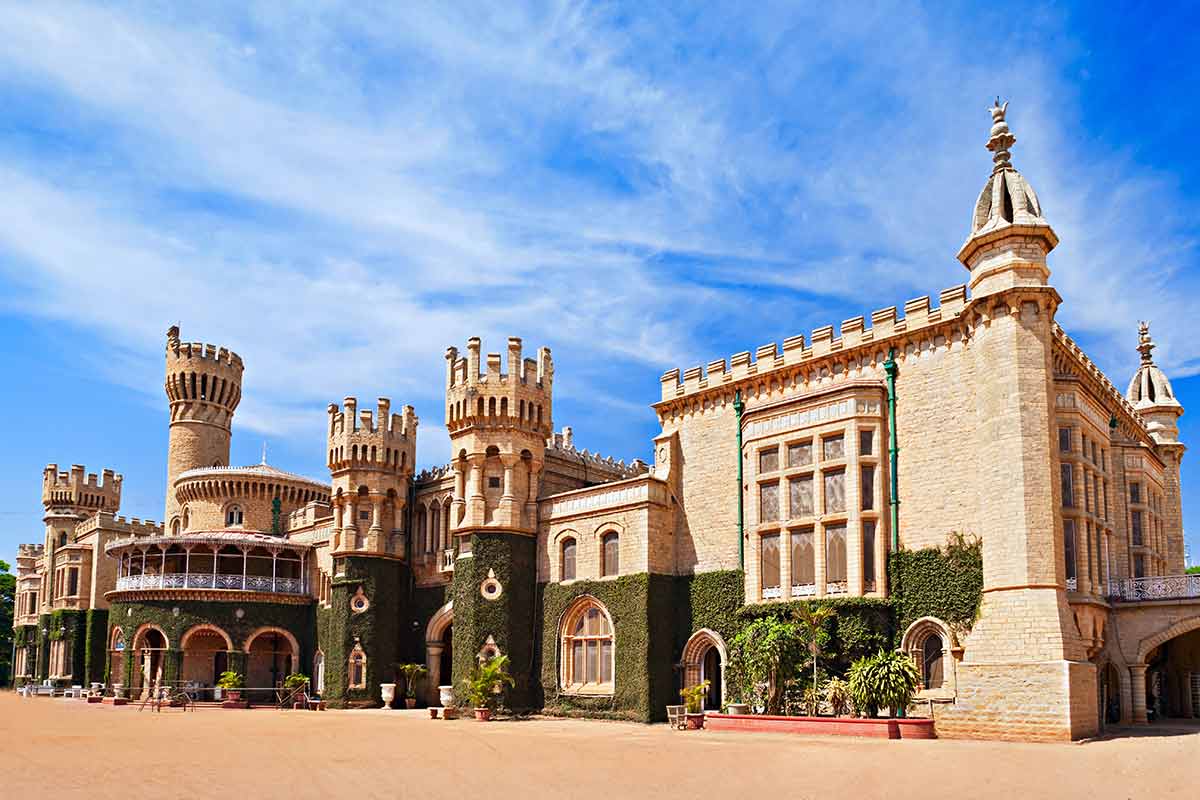
The appearance of turreted parapets, fortified towers, and battlements bang in the middle of the heritage heart of this erstwhile cantonment city is nothing short of a visual treat.
Bangalore Palace transports the visitors to an English countryside where this mix of Tudor and Scottish Gothic architecture might feel more at home.
Not surprisingly, the palace was inspired by the design of Windsor Castle.
Bangalore Palace belongs to the Wadiyar Dynasty, the rulers of the Kingdom of Mysore.
British Guardian of minor Maharaja Chamarajendra Wadiyar bought the land in 1873 and the palace was ready by 1878.
The sprawling grounds are a vast 454 acres (183 ha), and the floor area of the palace is 45,000 sqft (4180 sqm).
The intricate interior is filled with pillars and arches, especially the Durbar Hall on the first floor and the colourful courtyard fountain on the ground floor will leave you amazed.
The palace is also home to priceless paintings from Raja Ravi Verma and some Greek and Dutch masterpieces from the mid-19th century. In addition, there is a display of 1000 photographs charting the evolution of Bengaluru as a city.
The palace grounds hosts concerts by international bands like Metallica and Iron Maiden.
The palace administration operates an amusement park on-site called Fun World and there are cafes and restaurants.
Bangalore Palace is at Vasanth Nagar, Bengaluru, Karnataka.
Palace Hotels In India
7- Umaid Bhawan Palace, Jodhpur
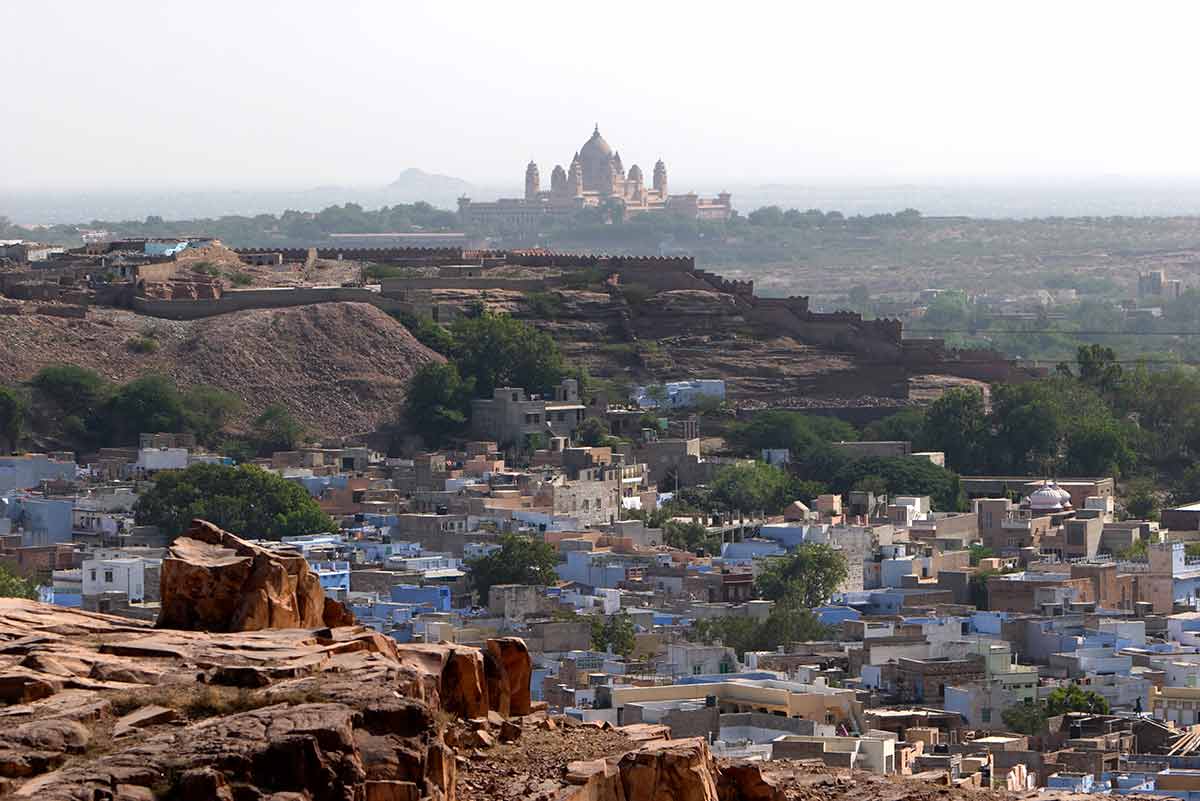
In the echelon of regal Rajasthani palace properties, Umaid Bhawan Palace, Jodhpur is a relatively new construction that was built between 1928 and 1943.
What it lacks in history, it makes up in size and grandeur.
Umaid Bhawan is just as imposing as Mehrangarh Fort, the historical gem of the Blue City.
History has it that this palace owes its origin to a curse cast by a saint when a prolonged drought hit the desert city.
The Rathore Dynasty ruler Maharaja Umaid Singh started the palace construction to employ the famine-hit farmers.
At present, his descendent Gaj Singh owns the palace, which is one of the largest royal residences in the world.
The building sports Indo-Deco architecture in Beaux-Arts style.
The palace is in three sections: the private residence of the royal family of Jodhpur, the Taj Palace Hotel and a museum.
The legacy of the Taj is palpable as soon as you enter the hotel. There are 22 rooms and 42 suites with Makrana marble bathrooms with bathtubs and luxury bath amenities.
You can opt for activities such as a therapeutic session at their acclaimed Jiva Spa, heritage walks and evening folk performances. Outdoor activities fit for a royal stay include squash, golf, polo and horse riding.
Umaid Bhawan Palace is at Circuit House Rd, Cantt Area, Jodhpur, Rajasthan.
8- Taj Lake Palace, Udaipur
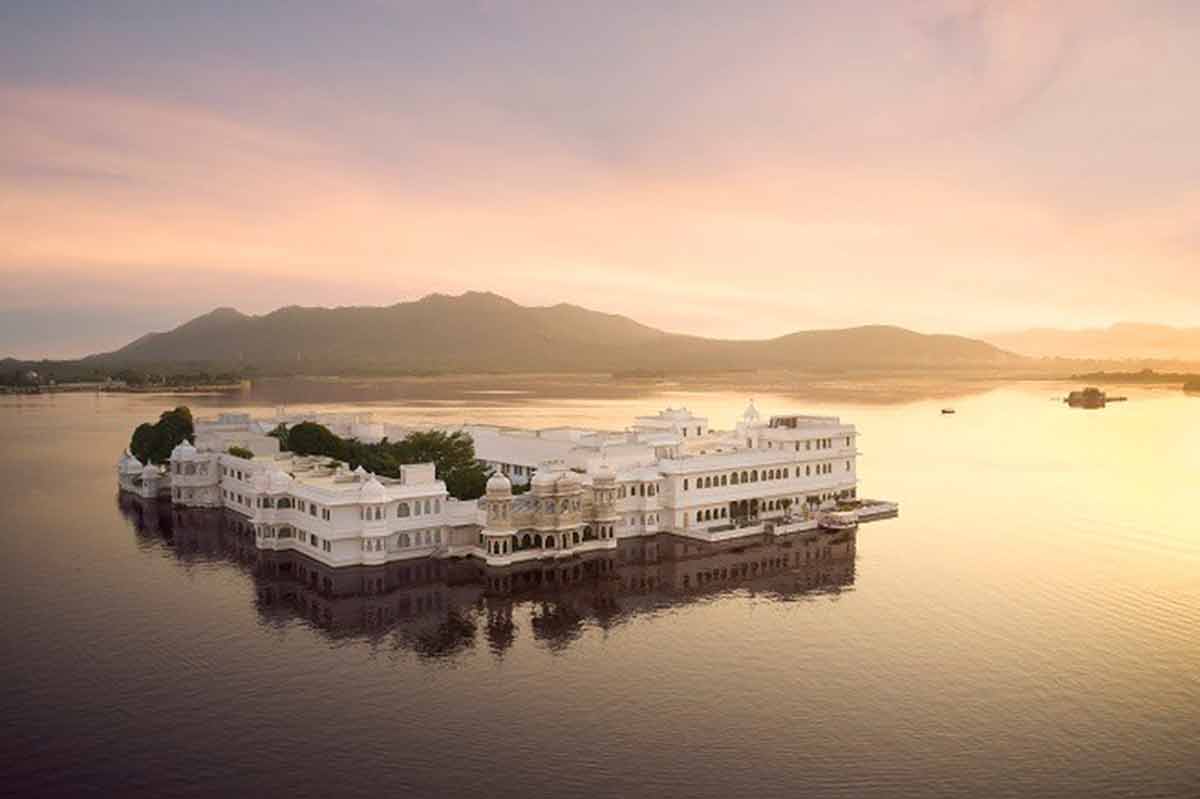
Channel your inner 007 at this Indian palace that made its appearance in another bond film, ‘Octopussy’.
Maharana Jagat Singh built jag Niwas after a tiff with his father. The latter refused his son permission to use Jag Mandir (another gorgeous lake palace on Lake Pichola) as a pleasure palace for his ladies.
The son just went ahead anyway and, in three years, created a magnificent palace on the lake in 1746.
Eventually, Taj took it over and renamed it as Taj Lake Palace. This bejewelled heritage property has 65 luxurious rooms and 18 grand suites.
Live like a royal with a palace butler service, royal historic boat romantic dinner, and boat spa service for a phenomenal princely experience.
The highlight is the palace’s location on the lake, with a stunning view of the Aravalli and Machala Magra hills as a backdrop.
Feed your inner prince or princess by pampering yourself in the Grand Presidential Suite, a lavish one-bedroom suite with a living room, dining, bedroom, and bathroom.
Taj Lake Palace is at Pichola, Udaipur, Rajasthan.
9- Taj Fateh Prakash Palace, Udaipur
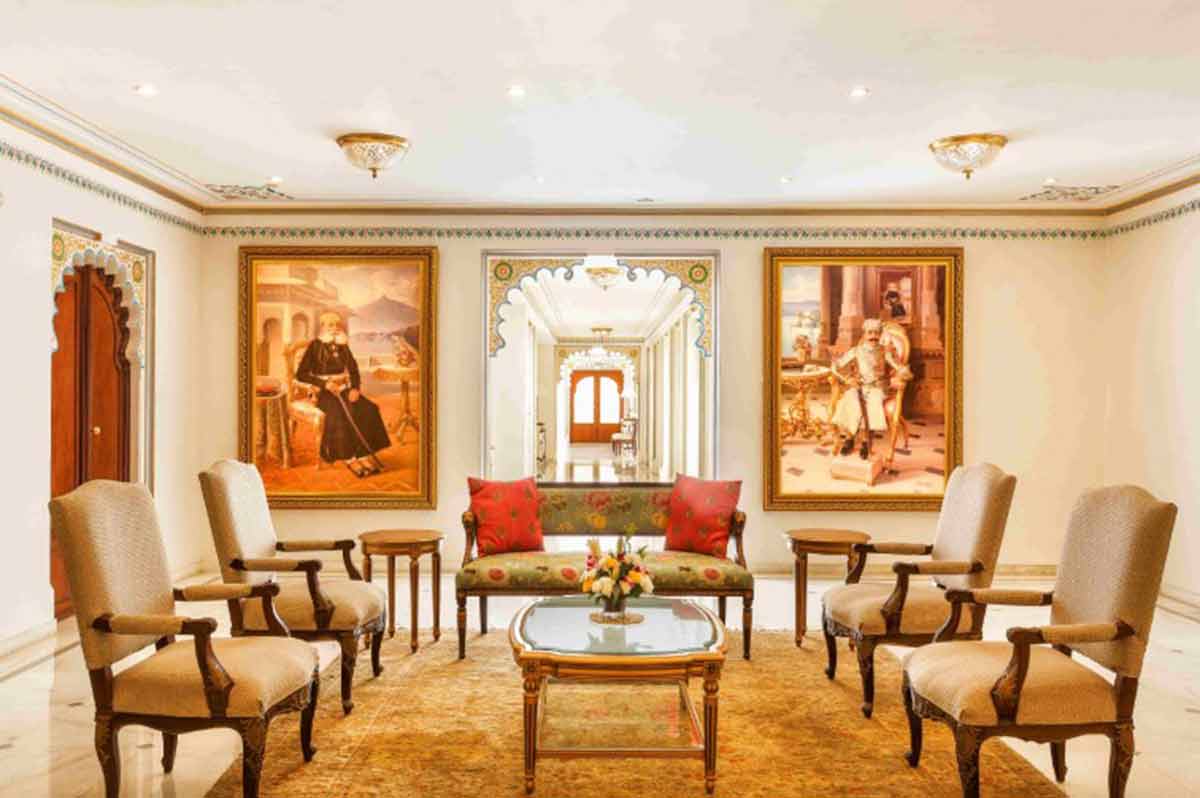
The reflection of the Aravalli mountain range on the glassy surface of Lake Pichola is an iconic sight from Taj Fateh Prakash Palace.
Dotted with palaces galore, Udaipur, the ‘City of Lakes’ has Havelis, mahals, mansions and palaces everywhere.
The Mewari past beckons from every building.
Constructed as an entertainment venue by Maharana Fateh Singh, this palace hosted many royal events.
A careful ear to the wall and one might still hear the past whispering of rustling chiffons and tinkling pearls.
Living in the luxe interior of the palace evokes a feeling of being in a museum.
The palace art, miniature paintings, jharokha or carved windows overlooking the lake, heirloom armoury adorning the walls are impressive.
The palace is painted in eye-soothing pastels reflecting the sandy dunes of the desert country.
Live like a Maharaja or Maharani in the Royal Suite and let the palace’s butler wait on you hand and foot.
Taj Fateh Prakash Palace is at Lake Pichola, The City Palace Complex, City Palace Rd, Udaipur, Rajasthan.
10- Neemrana Fort Palace
Neemrana Fort Palace is a massive 15th-century fort on the Delhi to Jaipur highway.
With its 77 rooms and suites built over 14 tiers, Neemrana Fort-Palace wraps itself around the Aravalli hill face, creating an exquisite canvas of yesteryear Rajput grandeur.
Constructed in 1464, the fort was abandoned in 1947, the year India won independence.
Raja Rajinder Singh couldn’t keep up with the maintenance, and the fort started crumbling. But fate intervened in 1986 when Indian citizen Aman Nath and French banker, Francis Wacziarg, bought and renovated the ruin.
Maintaining the heritage feel, the fort has steep steps and original ramparts.
Romance is in the air with a hanging garden, pools, spa, in-house camels and hidden nooks.
Neemrana Fort Palace is at 15th Century, Delhi-Jaipur Highway 122nd Milestone, Neemrana Fort Rd, Neemrana, Rajasthan.
Rambagh Palace oozes opulence, with rooms decked out in silk drapes, rich fabrics, lavish furnishings and objects d’art.
If it’s your first time in India, visiting this palace is a great way to get a royal experience.
Even if you’re not staying there, head there for a meal or afternoon tea as it’s one of the most amazing places to visit in Jaipur.
Guests can play polo, feast under elaborate chandeliers and gaze indolently at lovely royal gardens.
Built in 1835, the palace was the home of the queen’s favourite handmaiden before becoming a royal guesthouse and hunting lodge.
1925 was the start of more glamorous times when handsome polo-playing Maharaja Sawai Man Singh II made it his home.
The Maharajah and his Maharani, Gayatri Devi, were feted by English high society.
The Maharani was named the most beautiful woman in the world by Vogue magazine in 1940.
Visiting Rambagh Palace is one of the things to do in Jaipur you shouldn’t miss.
The most distinctive of its 79 rooms and suites are the Peacock Suite and the Maharani Suite, which was redecorated by the Maharajah’s favourite designer, Hammond’s of London, as a gift to Maharani.
It has wood panels, intricate mirror-and-stone work and hand-painted Rajasthani art.
There is a sitting area, dining space, an oval mirrored bathroom and palatial French windows opening to views of the Oriental Garden.
Combine a stay at Rambagh Palace in Jaipur with a luxury train journey aboard the Maharajah Express for a holiday you’ll never forget.
Taj Rambagh Palace is at Bhawani Singh Road, Jaipur, Rajasthan.
12- Falaknuma Palace, Hyderabad
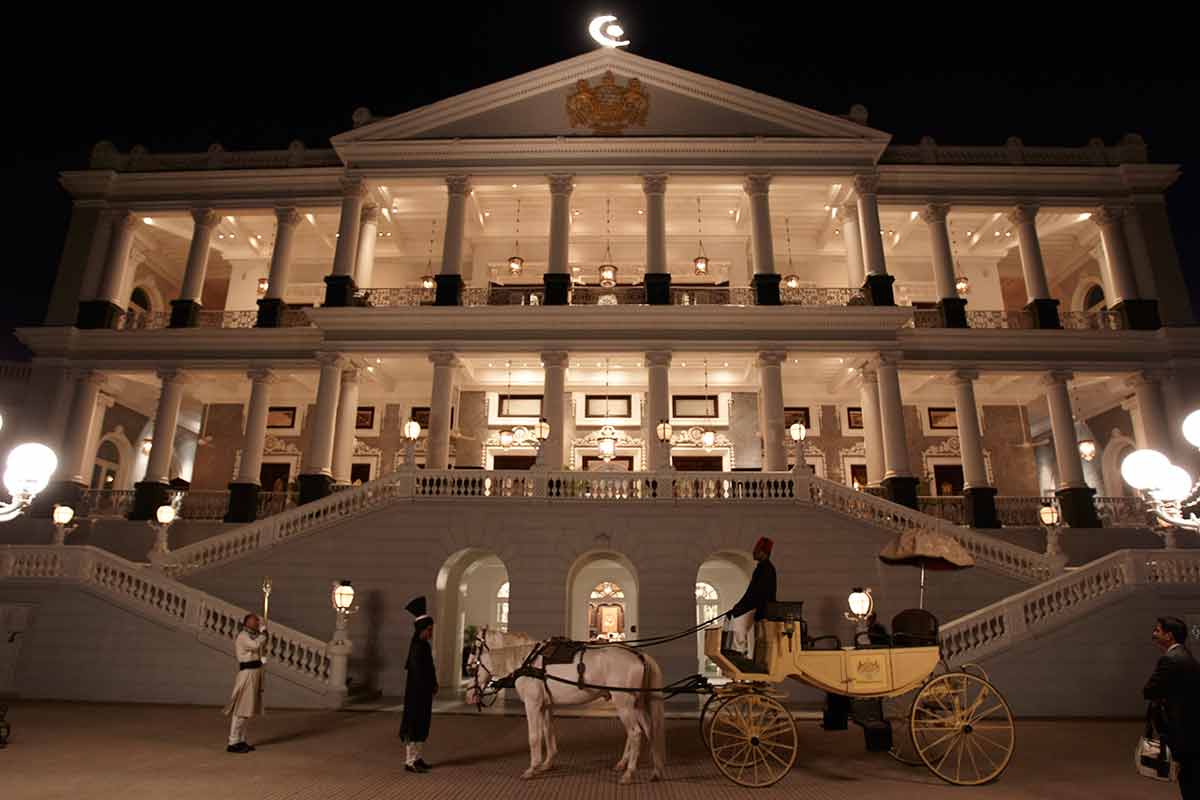
Hyderabad is an intriguing city to add to your Indian itinerary for many reasons.
In the 1940s, Hyderabad’s Nizam, Osman Ali Khan, was the richest man in the world. He was rated fifth highest on the Forbes All-Time Wealthiest List (Bill Gates ranked 20th) in 2008.
He owned an airline, postal service and flippantly used the 187-carat Jacob diamond as a paperweight.
His private treasury had stockpiles of gold, silver, precious gems and enough pearls to fill an Olympic size swimming pool.
Falaknuma Palace was the Nizam’s most lavish home, and where royal visitors such as George V, Edward VIII and Tsar Nicholas II came to stay.
When India gained independence, the palace was shut up for about 30 years and re-opened in 2010 after a 10-year-long restoration, by the Taj Hotel group.
Its former opulence has been recaptured with chandeliers, grand marble staircases, statues, objets d’art and a Palace Library that is a replica of the one at Windsor Castle.
The Grand Presidential Suite is an ornate two-storey abode with a private swimming pool and Jacuzzi, custom-designed furnishings from Turkey and Cararra marble floors.
Taj Falaknuma Palace is at Engine Bowl, Falaknuma, Hyderabad.
13- Taj Mahal Palace, Mumbai
Built as a hotel in 1903, by industrialist Jemsetji Tata, Taj Mahal Palace has been a favoured haunt for Maharajas and dignitaries from around the world.
The hotel was Mumbai’s first harbour landmark and had the first licensed bar in the city.
The hotel’s design combines Moorish, Indian and European styles.
It is decorated with a collection of treasures such as Bastar tribal art, Anglo-Indian inlaid furniture, Mughal-inspired Jali designs and Belgian chandeliers.
The Presidential Suite (President Obama stayed there in 2010) is a lavish 15-room residence with a dramatic domed living room that has a gold stencilled ceiling and enormous crystal chandelier.
It comes with a gym, a business centre, a 10-seat dining room and a staff of 13 including a personal chef and butler. Works from Indian artists M.F. Husain, Ram Kumar and Laxman Shreshtha adorn the walls.
It has a private spa with a steam room, sauna and two masseurs to administer treatments from the hotel’s Jiva spa menu.
This hotel is one of the iconic things to see in Mumbai.
Taj Mahal Palace is at Apollo Bunder, Mumbai.
14- Devi Garh, Udaipur
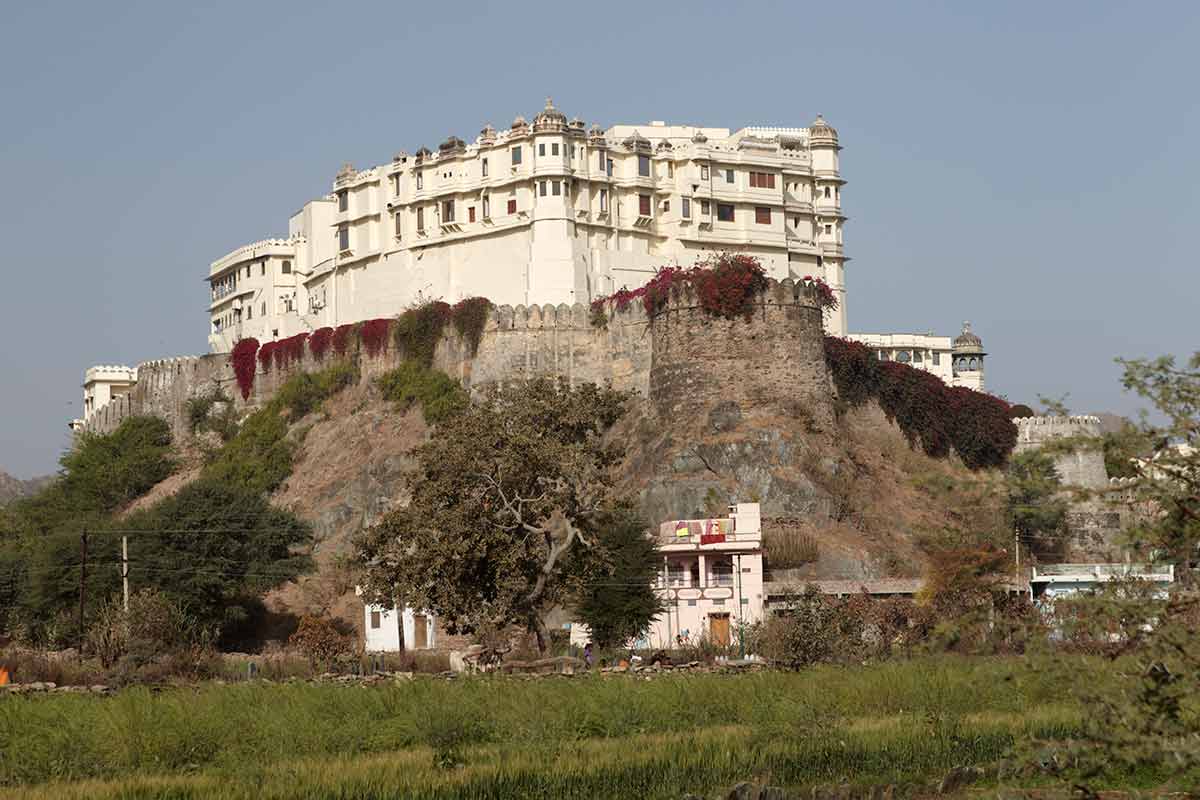
The 18th-century Devi Garh fort palace – which sits above the village of Delwara – has been stunningly remodelled into a 39-suite boutique hotel.
The re-design is an intriguing combination of historic structure and sleek contemporary living revolving around five courtyards.
A warren of passageways and staircases lead to rooms and halls where classical Indian and 21st-century design elements accomplish an eye-catching fusion look.
Part of its charm lies in the palace’s countryside location, with peaceful views of the Aravalli hills and valley.
Also unique is the cultural immersion excursions to the village of Delwara, where time has stood still, at the foot of the fort.
Suites are visions of white, decorated with marble and semi-precious stones.
The Devi Garh Suite, which comes with its own swimming pool and Jacuzzi, and the Palace Suite combine to form the Devi Garh complex of two bedrooms.
It explores the concept of ‘Shiv’ and ‘Shakti’, male and female energies embodied in Shiva, the Hindu God of destruction and his consort Shakti.
Devi Garh is near Eklingji, Udaipur, District Rajsamand, Rajasthan.
15- The Leela Palace, Udaipur
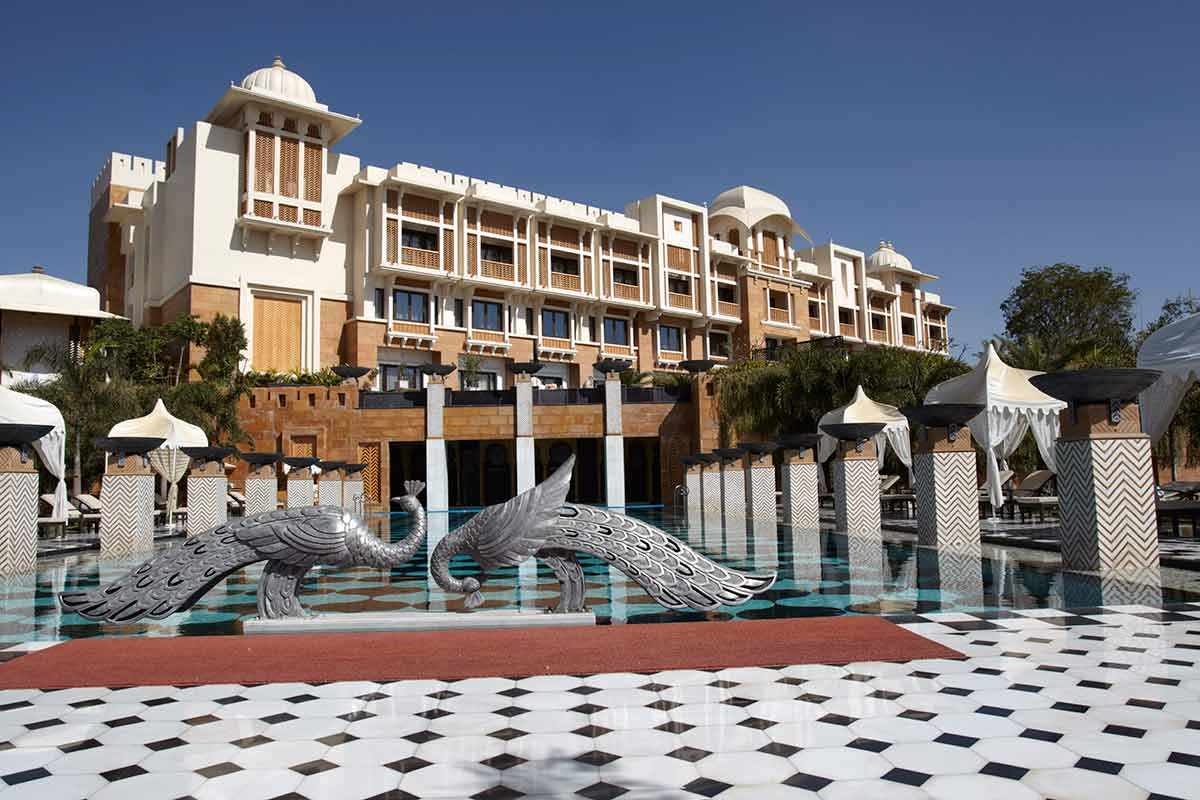
A stately glide in a royal barge across Lake Udaipur allows guests to arrive with much fanfare at Leela Palace.
The lake was the Mewar royal family’s playground and you could be forgiven for thinking that the sprawling Leela Palace, with its majestic gold curving domes was where Udaipur’s rulers once lived.
Built to resemble a traditional Indian palace, Leela Palace opened in 2009 and has an enviable lakeside location with fairytale views of the historic City Palace (Udaipur’s main attraction and museum), the hilltop Monsoon Palace (or Sajjan Garh) and Jag Niwas, which now operates as Taj Lake Palace, on an island on the lake.
With stately gardens, plush décor and slick service, this is a palace a modern-day Maharajah might choose to build from scratch.
The Maharaja Suite has a living room, study, dining area, master bedroom with a huge walk-in wardrobe, a king-size bathtub with a Jacuzzi and comes with its own massage room, plunge pool and courtyards.
Leela Palace is at Lake Pichola, Udaipur.
16- The Imperial, New Delhi
The Imperial opened its doors in the 1930s, at a time when India was in the throes of independence. Pandit Nehru, Mahatma Gandhi, Muhammad Ali Jinnah and Lord Mountbatten discussed politics in the dining rooms, tea lounges and Royal Ballroom.
The Nehru family had a permanent suite in the hotel. More recently, Brad Pitt, Angelina Jolie, Prince Albert of Monaco and Kate Winslet stayed at the hotel.
Silver tea service, tableware from London, Italian marble floors, Burmese teak furniture and green lawns create an aura of an early 19th-century English Manor in the heart of Delhi.
The Royal Imperial Suite has a 500-year-old clock that still keeps time, a dining area with a mahogany table for eight guests, a pantry, a study and a collection of 80 books, antique furniture and artworks by Prince Alexis Soltykoff.
The Imperial is at 1 Janpath, New Delhi.
17- Oberoi Grand Kolkata
The beauty of this hotel is the easy mix of old traditions and new blood, classic elegance and relaxed ambience.
The rooms are grand indeed and the service impeccable but it is the atmosphere that appeals, a reflection of the new India, vibrant, young and driven.
As Mr Anupam Dasgupta, now General Manager at the Oberoi in Mumbai, put it to me once: ‘A job at the Oberoi is not just a job. It is a career’.
With a remarkable eye for detail, thriftiness and organisation, Mr Oberoi transformed Clarke’s hotel in Simla into a household name.
The day in 1937 when on impulse he arrived in Kolkata to inspect the old ruin of a 500-room hotel was a fateful day.
Abandoned to dampness and decay for over a year and dammed by the death of five guests said to have succumbed to water-born bacteria spreading through the hotel’s ageing plumbing, the magnificent pile didn’t look promising, but it appealed to young Oberoi.
He went on to acquiring it to start the painstakingly hard job of bringing the hotel back to life.
Ripping off the entire plumbing system and replacing it with the best to be had, was only part of it.
Despite this, early guests remained cautious about the water. Mr Oberoi promised a magnate friend of his to provide him with free soda water not only to drink but also to brush his teeth with if he felt unsure about the water.
The word spread and was distorted till the final version had it “that a rich Punjabi had taken over the Grand Hotel, that whisky flowed like water and the bathtubs were filled with soda water”.
Over a year of intense labour, every carpet, silver candlestick and giant chandelier were meticulously cleaned, buffed and restored to its former glory.
New top quality beds were purchased and more importantly, the then unemployed former hotel staff was re-hired into their old positions but rigorously re-trained in the new Oberoi system.
So it was, that one destitute lady became the Grande Dame of Chowringhee where everybody who was somebody wanted to be seen at Grand gala balls, international entertainers and world-known celebrities flocked to the Grand after it threw its gates open on 21 December 1938.
Today, despite intense competition from international chain hotels, the Oberoi Grand remains at the forefront of Kolkata’s preferred destination for discerning travellers who delight in its unique service, dining facilities, live jazz at the Chowringhee Bar, the Spa and the exotic award-winning Baan Thai, the Thai restaurant.
Check the latest prices for Oberoi Grand Kolkata
18- Maison Perumal, Pondicherry
A far cry from the grand palaces of Rajasthan and the luxurious Nizam’s abode of Hyderabad, this 130-year-old Chettinad Mansion in Pondicherry evokes a feel of understated elegance with its culture-laced courtyards and quaint native architecture.
Tucked away in the tranquil corners of the Tamil quarter, Maison Perumal captures the colonial aura of this erstwhile sleepy seaside Frenchtown.
With minimalism at its heart, this generations-old family bungalow has been restored lovingly by the much-acclaimed CHG Earth group.
Travellers who enjoy intimate and immersive stays where privacy is sought after will revel in the seclusion of this boutique property.
With only 10 rooms, this peaceful paradise has secret staircases, teakwood columned courtyards, stained glass balconies, tropical plants, and goldfish and lily ponds.
Rooms are sized generously, and the décor pays homage to its Franco-Tamilian roots.
The interior resembles a simple yet prosperous traditional Tamilian home with its antique furniture and earthy terracotta flooring.
Staying at Maison Perumal is deeply cultural as it celebrates everything local.
The in-house restaurant rustles up mouthwatering culinary spread from locally grown produce.
Plenty of cultural activities like rickshaw tours, heritage quarter e-biking, kolam making, and culinary classes with local chefs offer a taste of local Pondicherry cuisine.
Maison Perumal is at 44 to 58, Perumal Koil St, Heritage Town, Puducherry, 605001.
19- Taj Nadesar Palace, Varanasi
Set amidst a fragrant field of jasmine, marigold, and a mango orchard, Nadesar Palace is a pleasant break away from the cacophonic and crowded Ghats of Varanasi.
First built by the East India Company in the 1700s, this property changed ownership eventually when Maharajah Prabhu Narain Singh of the Royal House of Benaras acquired it in 1889.
Taj Group took over its management in the 2000s and restored it to its former glory.
Nadesar Palace has entertained illustrious guests like Prince and Princess of Wales and Lord and Lady Mountbatten.
The palace sports a neo-classical architecture, and its interior harks back to the colonial British Raj era with its high ceiling, marbled corridors, and arched doorways.
Art from Maharajah’s collection is peppered liberally around the property.
Stepping into royal shoes starts right from the time of arrival.
A conch-shell welcome, a stay at their history-soaked palace suites and rooms, traditional medicinal treatments at their spa, a horse carriage driven tour of the grounds and relations with the past deepens!
All rooms are equipped with a standalone claw-foot bathtub and come with butler service.
You can choose to cool off in the backyard outdoor pool overlooking the extensive palace grounds or tee off at their mini-golf course.
A dip in the step-well-style spa pool is a must!
Sampling a Satvic Meal at their in-house restaurant must not be missed as it is the epitome of a clean and simple yet nutritious meal.
Taj Nadesar Palace is at Nadesar Palace Grounds, Uttar Pradesh 221002.
20- Ferrnhills Royale Palace, Ooty
Ferrnhills served as a summer palace for the Mysore Royal family from the Wadiyar dynasty.
Ooty was always a favoured hill town for the imperial colonizers from the Madras Presidency and the Indian royalties to escape the ungodly summer sun.
This sprawling Swiss Chalet-style property exudes heritage from its picturesque facade – an arty blend of gothic, regency, and neo-classical styles of architecture.
The opulent red building with its intricate white trimmings and accents stands out gloriously from the breathtaking backdrop of tall pine trees.
Rolling hills unfurl with cardamom estates and terraced tea plantations to complete the captivating scenery.
A step inside and walls made of Burmese teak wood and papier-mache ceiling will greet the visitors.
The alleys and halls are decorated with genuine period furniture and old photographs from the first English owners to the Mysore royalties.
The rooms offer an atmospheric stay with wooden floors and authentic teak furniture, and colonial décor.
Suites are decked out with unique characteristics like crystal chandeliers, Persian carpets, and separate spaces for bedrooms, living areas, dressing rooms, and verandahs.
All come with private Jacuzzi fitted bathrooms.
The gorgeous grounds are ideal for high teas and sundowners.
Dining at the palace ballroom converted dining hall is a scrumptious affair where food is personalised according to guests’ preferences.
Ferrnhills Royale Palace is at Ferrnhills Post, Ooty, Tamil Nadu 643004.
21- Chapslee, Shimla
The ivy-laced stone walls, the serene country setup, and the artful décor make this two century’s old Scottish House an instant time capsule.
Owned by the family of Raja Charanjit Singh of Kapurthala, the heritage bungalow offers an unmatched experiential and luxurious stay surrounded by the mighty Himalayas.
The fascinating fact about the cottage is its local ‘dhajji’ architecture that keeps the interior cool during summer and warm during winters.
Though a company official constructed it, it warms the heart to see their respect for local knowledge.
The yesteryear grandeur is cultivated with precision here.
From the food to the interior, the regal lifestyle of Raja Charanjit is reflected everywhere.
The silver cutlery, the dinner thalis loaded with delicacies from around the world, the garden room where one can sip tea with mountain mists wafting in from the French windows, a time spent here is dreamy.
Nothing can get truly majestic than staying in Charanjit’s room, the Luxury Suite.
It has three fireplaces, Venetian cabinets, Afgan and Persian carpets and rugs, Belgian and Italian chandeliers, and a plethora of English paintings on the wall.
Chapslee is at Elysium Hill, Longwood Rd, Near, Lakkar Bazar, Shimla, Himachal Pradesh 171001.
22- Ahilya Fort Hotel, Maheshwar
By the holy river of Narmada in Central India lies the royal seat of one of the illustrious rulers of the land, Rajmata Ahilyabai Holkar.
Widowed at the young age of 29, she shook off her misfortune and went on to become a brave warrior, a crafty politician, and an efficient ruler of the Indore region.
Losing her husband, father-in-law, and son in quick succession could not stop this badass from barging into the battlefield with her armies and decimate the plundering Malwa.
During her active rule, which lasted from 1767 to 1795, she erected her residence, locally called Ahilya Wada, which has been now converted into a heritage boutique stay by her descendent Prince Richard Holkar.
Strewn across six buildings of the fort are nineteen rooms decked out in romantic period furniture.
Each has its individually decorated with and named after either birds or flowers.
The atmosphere is quirky with original carved wooden doors from the 18th century and pale stone floors.
Regional handicrafts adorn every nooks and cranny giving it a colourful local vibe.
Mornings here begin with a lovely river sunrise and a breakfast at the open mandap area.
The fort has secluded spots where you can unwind in peace.
A candle-lit dinner by the tropical pool is a cherry on the top to conclude a beautiful India trip.
Ahilya Fort Hotel is at Ahilya Wada, Maheshwar, Madhya Pradesh 451224.
Are you inspired to visit India now? Most visitors will require an Indian visa. India is a huge country and there’s lots to see. If it’s your first time in India, Rajasthan is a good place to start. Another fabulous way to spend a few days is cruising the Kerala backwaters. If you’re a fan of cruising, you might also want to try a Brahmaputra River cruise or a Ganges River cruise. Here are some things to do in Kolkata.
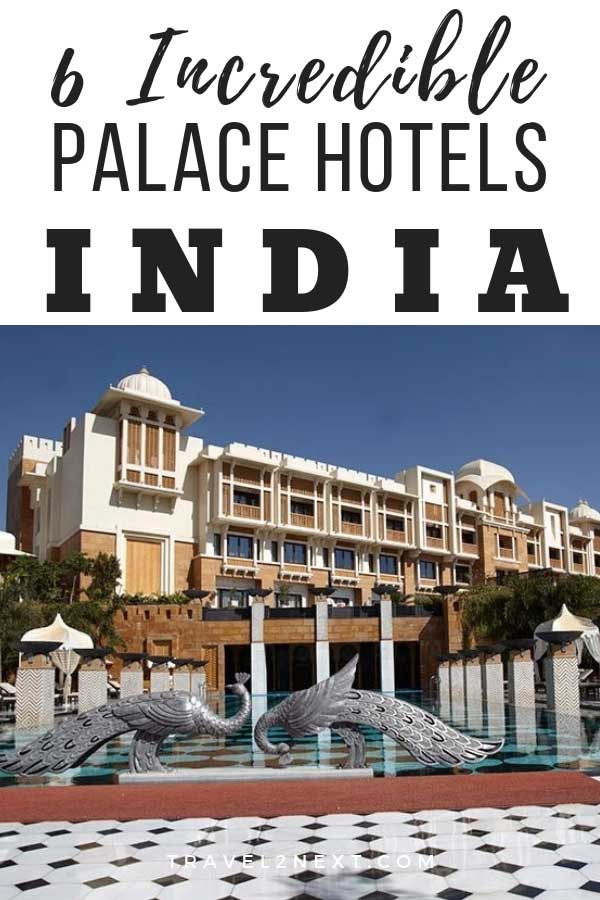
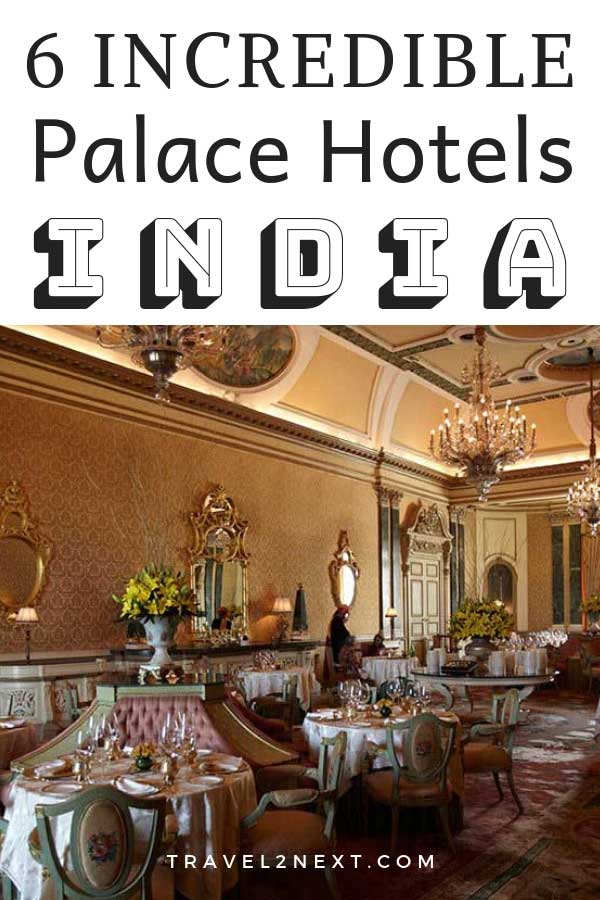
Plan Your Trip

Rent A Car – Find the best car rental rates at Discover Cars. They compare car hire companies to provide you with the best deal right now.

Find A Hotel – If you’re curious about this article and are looking for somewhere to stay, take a look at these amazing hotels.

